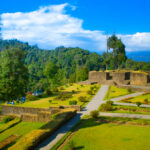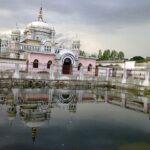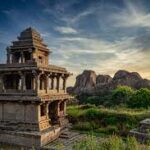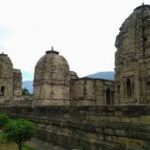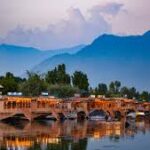Now Reading: Best Places Visiting in Nawada for Nature, Heritage & Spirituality
-
01
Best Places Visiting in Nawada for Nature, Heritage & Spirituality

Best Places Visiting in Nawada for Nature, Heritage & Spirituality
1. Kakolat Waterfall

Bihar boasts Kakolat Waterfall as its most spectacular tourist destination which rests in a region of abundant vegetation. The waterfall drops at 160 feet and creates a pure natural lake that attracts visitors who enjoy nature activities while also serving as a religious site for pilgrims. Visitors can find this breathtaking view on the Kakolat Hill in the Nawada district where they can enjoy a peaceful environment.
The natural beauty of Kakolat Waterfall extends beyond visual appeal since this site holds spiritual significance which people consult. Following the legend from the Treta Yuga a king received divination from a holy man turning him into a serpent dragon that needed to reside at Kakolat. A divine curse ended when the Pandavas stopped at the location during their royal exile. The belief exists that any person who immerses themselves in Kakolat Waterfall becomes freed from charms and will never experience snake rebirth.
Many pilgrims visit the spiritual site at Kakolat Waterfall to receive blessings and achieve purification because of these beliefs.
A mesmerizing environment which calms the mind surrounds Kakolat Waterfall due to its position among dense forest vegetation and rocky terrain. The tall Kakolat Hill serves as a source that drives water downward to create a flawless lake in its base. The refreshing waterfall stays delightful in summer temperatures which draws many residents along with tourists towards this spot.
Best Time to Visit
Summer months between April and June offer the perfect opportunity to visit Kakolat Waterfall because the cool refreshing environment with green vegetation helps combat summertime heat. Visitors should be cautious during July to September monsoon period due to slippery paths although the waterfall’s beauty increases with enhanced water flow. The period from October to March offers a wonderful opportunity to experience the pleasant climate and scenic views at Kakolat Waterfall.
2. GUNAWA JAIN MANDIR
A place of enormous importance for Jain believers resides in the Nawada district of Bihar at Gunawa Jain Mandir. Many thousands of devotees visit this esteemed temple yearly because they seek blessings and want to experience mystical peace in this holy sacred area.
Religious importance of the temple grows stronger because it stems historically from the period when Lord Mahavira appeared as the 24th Tirthankara of Jainism. According to Jain belief Indrabhuti Gautam Gandhara reached supreme knowledge (Kevala Jnana) at a sacred location where he had served Lord Mahavira as the most devoted disciple. A fundamental Jain notion describes Kevala Jnana as a quality which grants spiritual enlightenment with omniscience to achieve the highest sublime state before liberation. The Gunawa Jain Mandir has gained sacred status because of this deep religious occurrence.
Gunawa Jain Temple features distinct positioning and extraordinary buildings that make it stand out among other Hindu temples.
The temple distinguishes itself by its placement inside a lake. The temple exists in the central portion of a peaceful lake that simultaneously boosts its aesthetic value and cultivates a peaceful atmosphere. When the temple image reflects on the lake surface it creates an enchanting and holy atmosphere around the site.
The temple complex contains forty small temples distributed throughout its premises that commemorate various religious teaching and crucial figures from Jain history and doctrine. Gunawa functions as a prime Jain religious and meditation hub because of its distinctive architectural format.
The religious faithful who visit Gunawa Jain Mandir are convinced that temple worship evolves their faith and grants both peace and freedom from earthly needs. Devotees of Jainism participate completely in traditional worship ceremonies while using the temple grounds for peaceful meditation and complete absorption of spiritual teachings.
During Jain festivals together with special religious gatherings the temple serves as a center which attracts faithful attendees from multiple areas of India. Devotees conduct prayers and perform religious ceremonies while having spiritual discussions that build a devout environment.
Best Time to Visit
The optimum period to explore Gunawa Jain Mandir falls within Jain observance days that include Mahavir Jayanti along with Paryushana and Diwali. When Gunawa Jain Mandir hosts its festivals the temple receives elaborate decorations that create a mystical spiritual environment from the celebratory atmosphere.
Visitor comfort increases throughout the period between October and March because of the pleasant weather conditions in Namakka district.
3. Sarvodaya Ashram

The Nawada district of Bihar contains the major historical and cultural center of Sarvodaya Ashram within the village of Shekhodeora. The Ashram serves as an important historical landmark under the leadership of Bharat Ratna Loknayak Jai Prakash Narayan who remains one of India’s greatest freedom fighters and social reformers.
History
Ashram acquired its purpose to promote Sarvodaya (upliftment of all) and social transformation through Jai Prakash Narayan’s establishment. Loknayak Jai Prakash Narayan and his wife Prabhavati Devi spent considerable time at this Ashram to support the India’s freedom movement and later work on Bihar Movement and Total Revolution.
During the post-independence period the Ashram evolved into a major social and political meeting place which was situated near areas of natural beauty. This establishment continues today as a physical representation of everything Jai Prakash Narayan stood for about the values of self-reliance and social justice and simplicity.
What to Explore at Sarvodaya Ashram
Sarvodaya Ashram provides visitors a chance to engage with historical items including relics and structures which commemorate Jai Prakash Narayan’s lifetime accomplishments. Some notable features include:
Memorabilia of Jai Prakash Narayan:
Various personal objects along with photos and historical documents that focused on the life work of Jai Prakash Narayan and Prabhavati Devi exist at the location.
Historical records demonstrate the Bihar Movement and its revolutionary concept of Total Revolution developed by him.
Simple Living Spaces:
The residential areas demonstrate the modest lifestyle which Jai Prakash Narayan both practiced and promoted.
Library and Study Center:
A small library at the Ashram contains books about history and social reform together with Gandhian philosophy enabling Jai Prakash Narayan to develop his thoughts and actions.
Peaceful Surroundings:
Calm reflection and meditation opportunities are available to visitors at the Ashram because it rests within beautiful scenic area.
History lovers together with freedom movement admirers may experience the life story of a great national leader through the circumstances of Sarvodaya Ashram. Visitors should place Sarvodaya Ashram on their travel list because it contains historic links to the Quit India Movement along with the Total Revolution.
The Ashram creates an environment that perfectly matches the needs of people looking for a relaxing place for mental self-improvement.
Best Time to Visit
Wintertime during October to March offers the perfect opportunity to discover Sarvodaya Ashram because of its comfortable climate conditions.
Related articles : Top 5 Best Places Visiting in Narayanpur for Nature, Culture & Spirituality














